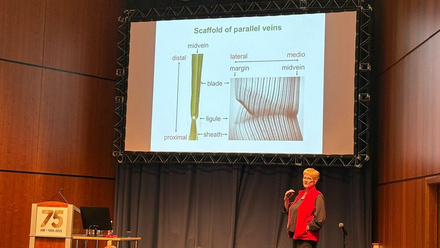JXB Volume 72, Issue 22 – Editor’s choice
JXB VOLUME 72, ISSUE 22 – EDITOR’S CHOICE
This article highlights the following publication:
The C4 cycle and beyond: diverse metabolic adaptations accompany dual-cell photosynthetic functions in Setaria
Paula Calace, Tomás Tonetti, Ezequiel Margarit, Carlos M Figueroa, Carlos Lobertti, Carlos S Andreo, Mariel C Gerrard Wheeler, Mariana Saigo
Journal of Experimental Botany, Volume 72, Issue 22, 4 December 2021, Pages 7876–7890, https://doi.org/10.1093/jxb/erab381
C4 photosynthesis in green millet: a model of efficient cell specialisation
The enzyme Ribulose-1,5-bisphosphote carboxylase/oxygenase, commonly shortened to RubisCO, is a key player in photosynthesis and enables life on earth as we know it by funnelling inorganic carbon into organic sugars. Its bulky name describes its dual function in different enzymatic reactions: RubisCO can either catalyse the photosynthetic carboxylation reaction between carbon dioxide and ribulose-1,5-bisphosphate, or oxygenate this C5 sugar by using O2 instead of CO2. The latter process, called photorespiration, yields harmful metabolites that need to be detoxified in an energy-demanding chain of reactions thereby decreasing the photosynthetic efficiency in many plants by about 25%. However, certain species have evolved mechanisms to force RubisCO to stick to its carboxylation activity by confining its localisation to specialised cells and increasing the CO2 concentration in its environment. This carbon concentration mechanism requires special anatomic and physiological adaptations. In so-called C4 plants RubisCO can only be found in chloroplasts of bundle sheath cells that typically surround the leaf vasculature. The initial carbon fixing step, however, takes place in mesophyll cells where CO2 is captured into C4 organic acids via the activity of phosphoenolpyruvate (PEP) carboxylase, an enzyme without affinity for oxygen. The C4 compound is then transported into the bundle sheath cells where CO2 is enzymatically released in the immediate vicinity of RubisCO. This process reduces the RubisCO oxygenase activity substantially, thereby not only increasing the photosynthetic output but also the water use efficiency and nitrogen use efficiency of C4 plants.
C4 species are traditionally divided into three types depending on the predominant decarboxylating enzyme that releases CO2 in bundle sheath cells: NADP-malic enzyme (NADP-ME), NAD-malic enzyme (NAD-ME), or phosphoenolpyruvate carboxykinase (PEP-CK). These types of C4 photosynthesis differ, however, not only in one single enzyme but the entire biochemical and structural makeup of mesophyll and bundle-sheath cells shows distinct characteristics. For example, plants of the NAD-ME subtype have a higher number and/or volume of mitochondria in bundle sheath cells due to the localization of NAD-ME in this organelle. Furthermore, these mitochondria are equipped with membrane transporters that enable uptake of aspartate, the selected transport metabolite between mesophyll and bundle sheath cells in these species.
Research on C4 photosynthesis has so far mainly focussed on agronomically important C4 crops such as maize and sorghum. In the latest JXB issue Calace et al. (2021) report on the metabolic strategies underlying the C4 cycle in Setaria viridis, commonly known as green millet, and uncover that this humble looking grass held unrevealed secrets that broaden and refine our current understanding of C4 metabolism.
The proteomic analysis of mesophyll and bundle sheath cells in Setaria leaves performed by Calace et al. showed that the functional specialisation of these cells is not limited to photosynthesis, but also encompasses the spatial separation of, e.g., amino acid and lipid metabolism. These processes thus rely on close cooperation between both cell types. Next to providing a general overview of the cellular protein landscape the authors also compared the proteome of the subcellular compartments chloroplast, mitochondria, and peroxisomes to gain a more fine-grained insight into their unique characteristics. In contrast to findings in maize, enzymes involved in the shikimate pathway for aromatic acid biosynthesis were enhanced in Setaria bundle sheath cell chloroplasts whereas these processes predominate in the mesophyll in maize. According to the authors low activity of the shikimate pathway in mesophyll chloroplasts could reserve PEP for carboxylation by PEP carboxylase, the first step in the carbon concentration mechanism, thereby avoiding interference with the C4 cycle carbon flow.
One chloroplastic NADP-ME isoform was identified in bundle-sheath chloroplasts as the main C4 cycle decarboxylase. Its catalytic characteristics were similar to the ones found in other C4 species such as maize and sorghum and its high abundance and catalytic proficiency suggest the general categorization of Setaria as NADP-ME subtype. The presence of only one NADP-ME isoform that is omnipresent in different cell types throughout the whole plant indicates its functional contribution to metabolic pathways other than photosynthesis. In maize, by contrast, two different isoforms exist that have evolved from a common C3-type gene: one fulfilling non-photosynthetic functions in organs such as roots, and one located in leaf bundle-sheath cells and involved in the C4 cycle.
Next to the chloroplastic NADP-ME two mitochondrial NAD-ME isoforms were found to be enriched in Setaria bundle-sheath cells. Their catalytic activities share characteristics with enzymes in C3 plants and could thus fulfil the same functions, e.g., in nighttime respiration, as is the case in the C3 model plant Arabidopsis. However, one novel property of the Setaria NAD-ME, namely its inhibition by the amino acid glutamic acid, points to an additional implication in C4 photosynthesis, since this attribute would enable NAD-ME to act as a regulatory hub between carbon and amino acid metabolism. This hypothesis is supported by the identification of potential C4 transporters in the mitochondria membrane in bundle-sheath cells, an essential prerequisite related to the NAD-ME C4 subtype. C4 species in which PEP-CK operates in concert with NADP-ME or NAD-ME, respectively, for CO2 supply to RubisCO have been reported before but combined C4-activity of NADP-ME and NAD-ME in bundle-sheath cells has to date not been confirmed with certainty and deserves further investigation.
Taken together, the results presented by Calace et al. indicate that the metabolic adaptations associated with the cell-type specialisation in Setaria leaves serve to insulate the C4 pathway and avoid leakage of intermediate compounds. They also provide evidence that Setaria may not perfectly fit any of the traditional C4 subtypes and these exciting findings open up new pathways for future studies.





